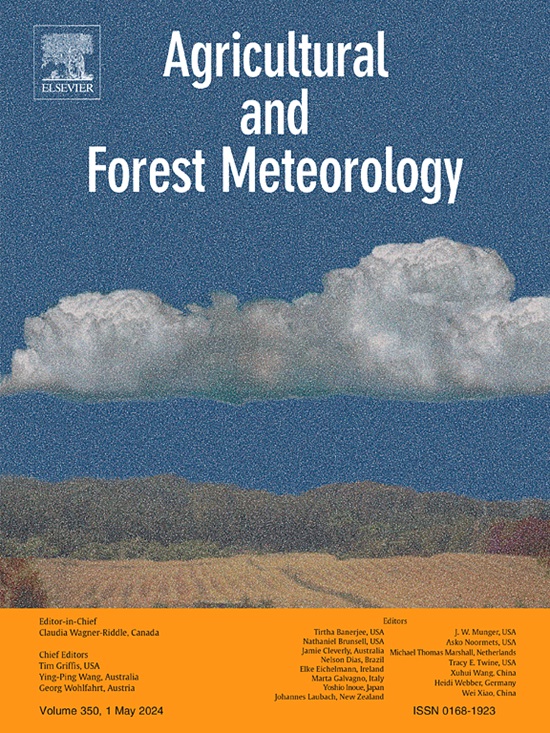Stability and transferability of broadly trained phenology models in a changing climate
IF 5.6
1区 农林科学
Q1 AGRONOMY
引用次数: 0
Abstract
A variety of phenology process-based models have been developed to simulate environmental influences on the timing of spring and autumn phenophases. Similar performances between different types of mechanistic models have raised questions about reliability of their predictions. To assess the biological relevance of phenology models, we used a seven-decade dataset of five species across 170 sites and 1700 m elevation in Switzerland. We evaluated nine leaf emergence and ten senescence models over time and space. We explored how optimal parameter values and influences vary, reflecting transitions in model aptitude and phenology responses to drivers. Leaf emergence models showed improved predictions at external sites over time, while emergence dates converged across Switzerland. In contrast, leaf senescence models often failed to outperform the null model predicting the mean date of training data and showed divergent performance trends. Trends in optimal parameters indicated species-specific responses to emergence drivers, with cold-climate suited species favouring earlier thresholds for warmth accumulation in spring, while the trends were opposite for warm-climate suited species, except for beech showing stable parameters likely due to strong photoperiod constraints. Warming increased the importance of chilling-related parameters for leaf emergence, while senescence parameter sensitivities remained stable. Spatial analyses revealed that complex models were less robust to training and validation at different elevations than simple models, and that phenological responses may vary non-linearly with elevation, likely due to local adaptations. Senescence models performed better with validation at high elevations, where climatic variables such as cooling temperatures play a large role, while predictions were more challenging at other elevations. These findings highlight the need for further refinement of process-based models to account for all driving influences on plant phenology, particularly for leaf senescence models. Our work demonstrates the potential for process-based modelling techniques to better understand phenology responses to climate change.

广泛训练物候模型在气候变化中的稳定性和可转移性
各种基于物候过程的模型已经开发出来,以模拟环境对春季和秋季物候期时间的影响。不同类型的机械模型之间的相似表现引发了对其预测可靠性的质疑。为了评估物候模型的生物学相关性,我们使用了瑞士170个地点和1700米海拔的5个物种的70年数据集。我们评估了9种叶片萌发模型和10种叶片衰老模型随时间和空间的变化。我们探索了最优参数值和影响是如何变化的,反映了模型能力和物候对驱动因素的反应的转变。随着时间的推移,叶子羽化模型在外部地点的预测结果有所改善,而瑞士各地的羽化日期趋于一致。相比之下,叶片衰老模型在预测训练数据平均日期时往往不能优于零模型,并且表现出不同的性能趋势。最优参数的趋势表明了物种对涌现驱动因素的特定响应,适合寒冷气候的物种倾向于更早的春季温暖积累阈值,而适合温暖气候的物种的趋势相反,除了山毛榉可能由于强烈的光周期约束而表现出稳定的参数。增温增加了冷态相关参数对叶片出苗的重要性,而衰老参数的敏感性保持稳定。空间分析表明,在不同海拔高度,复杂模型对训练和验证的鲁棒性不如简单模型,物候响应可能随海拔非线性变化,这可能是由于局部适应所致。衰老模型在高海拔地区的验证效果更好,在高海拔地区,气候变量(如降温温度)起着很大的作用,而在其他海拔地区的预测更具挑战性。这些发现强调需要进一步完善基于过程的模型,以解释对植物物候的所有驱动影响,特别是叶片衰老模型。我们的工作证明了基于过程的建模技术在更好地理解物候对气候变化的响应方面的潜力。
本文章由计算机程序翻译,如有差异,请以英文原文为准。
求助全文
约1分钟内获得全文
求助全文
来源期刊
CiteScore
10.30
自引率
9.70%
发文量
415
审稿时长
69 days
期刊介绍:
Agricultural and Forest Meteorology is an international journal for the publication of original articles and reviews on the inter-relationship between meteorology, agriculture, forestry, and natural ecosystems. Emphasis is on basic and applied scientific research relevant to practical problems in the field of plant and soil sciences, ecology and biogeochemistry as affected by weather as well as climate variability and change. Theoretical models should be tested against experimental data. Articles must appeal to an international audience. Special issues devoted to single topics are also published.
Typical topics include canopy micrometeorology (e.g. canopy radiation transfer, turbulence near the ground, evapotranspiration, energy balance, fluxes of trace gases), micrometeorological instrumentation (e.g., sensors for trace gases, flux measurement instruments, radiation measurement techniques), aerobiology (e.g. the dispersion of pollen, spores, insects and pesticides), biometeorology (e.g. the effect of weather and climate on plant distribution, crop yield, water-use efficiency, and plant phenology), forest-fire/weather interactions, and feedbacks from vegetation to weather and the climate system.

 求助内容:
求助内容: 应助结果提醒方式:
应助结果提醒方式:


